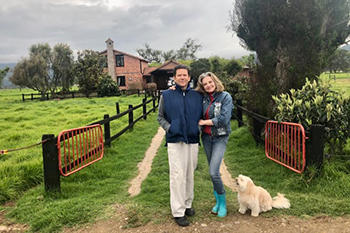Connecting to Others with a Rare Cancer Diagnosis
, by Marcela, Ependymoma Survivor
Marcela discovered an ependymoma in her spinal cord. She shares how she found support online and participated in a study while she was living internationally.
My whole life, I had almost perfect health. I live and work on a farm with my husband in South America. We care for eight dogs, four cats, one horse, and lots of cows. I‘ve been physically fit and active all my life.
In 2018, I started to have mild chronic back pain. The pain got worse within a year and expanded to my leg and left buttock. I couldn’t sleep. The pain was worst at night and in the morning. Getting out of bed was nearly impossible. My doctors didn’t think anything was seriously wrong because of my track record of good health. They said it was muscular and sent me to physical therapy. Yoga helped me deal with the pain.
One day I was fine and the next I felt horrible. I began to need pain injections to deal with normal life. I knew something bigger was going on. A magnetic resonance imaging (MRI) scan was the key to find my illness.
In October 2019, at age 54, my doctor discovered a tumor in my spinal cord between lumbar spine vertebrae L3 and L4. My doctor first thought it was a schwannoma, a benign tumor in the central nervous system. I could have never imagined having a tumor in my spine, but in a way I was happy to know I wasn’t crazy, and my pain had a real cause. The following month, I had surgery to remove the tumor. My neurosurgeon gave me the confidence I needed to cope with the surgery. Everything went well and I was at home three days later.
It took me a month to recover. I was able to drive after two months. It was a slow process, but if you remain positive and keep moving (slowly) all the time, things will go right. Living in the countryside surrounded by animals made the process easier. My bladder and bowel movements were very slow, but after a month things got better and now everything is all right.
After surgery, the first pathology result indicated the tumor was a grade 2 ependymoma. But after a second pathology reading, it ended up being a less aggressive grade 1 myxopapillary ependymoma, and I was relieved. The moment I knew I had a tumor in my spinal cord, I began researching to find out as much information as I could, because learning about what you have is very important. I found information on comprehensive cancer center websites through the Collaborative Ependymoma Research Network (CERN) Foundation and also by asking my neurosurgeon questions. By understanding my sickness, it made it easier to deal with it.
Remaining Positive
Staying positive was the best thing for me. I believe everything happens for a reason. Even before my surgery, I began thinking positively about my outcome. My neurosurgeon was great and I was very lucky because my tumor was in the filum terminale, or medullary cone, that is located in the lower end of the spinal cord. This is the biggest part of the spinal cord, and my doctor was able to remove the entire tumor completely without affecting any surrounding nerves. Almost seven months after my surgery, I am without any pain or side effects.
The best advice I can give others with a rare brain or spinal cord tumor is to be as positive as you can and believe in miracles.
Connecting with Others
I didn’t share my illness with anyone except my husband, son, and brother. It enabled me to concentrate on getting better instead of explaining what I was feeling or going through.
However, after I recovered, I realized I wanted to find others with ependymoma. Because this is a rare illness, I knew that I would only find support online. After some searching, I found NCI’s closed Facebook group, NCI-CONNECT Community, for people with rare brain and spine tumors including ependymoma. I wanted to know more about my illness and hear resources and advice from others. NCI-CONNECT Community provides great information, and I am able to interact with other patients with the same illness. A spinal cord tumor can be life threatening and cause permanent disabilities. After connecting with others, I have realized miracles happen. A miracle happened for me.
Participating in the Outcomes and Risk Study
I also wanted to help other people with ependymoma, so I decided to participate in NCI’s Outcomes and Risk Study. First, I participated in the outcomes survey, which is an an online questionnaire. The survey was very interesting because it included questions about my genetics, habits, health, and more. Next, I will send in a saliva sample to help researchers understand certain risk factors that may increase people’s chances of developing my tumor type.
Everyone eligible with rare brain or spine tumor should participate in this study, because it is the best way to help doctors find further information and make new discoveries. I hope that sharing my DNA sample and health information with doctors and investigators at NCI will help others in the future.
